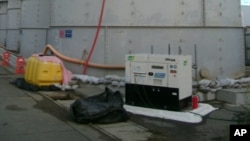TOKYO —
The owners of Japan’s damaged Fukushima nuclear plant, TEPCO, have apologized after several workers at the site were accidentally doused with highly radioactive water this week. Authorities do not believe they were exposed to a health risk. But the accident is just the latest in a series that have called into question TEPCO’s ability to manage a clean-up operation that could last decades.
The leak occurred when a lock was mistakenly removed from a pressure hose, dousing several workers with radioactive water. Manager of the Tokyo Electric Power Company, Masayuki Ono, appeared in front of cameras Thursday to apologize.
Ono said that six people have had their bodies irradiated and it was true that big mistakes like this continued to occur again and again. "It is therefore essential that we do something to stop this chain of events," he said.
The incident came just days after TEPCO reported that 430 liters of highly radioactive water had leaked into the ocean from storage tanks - the second such incident in as many months.
It earned TEPCO a strong rebuke from the Secretary General of Japan’s Nuclear Regulation Authority, Katsuhiko Ikeda.
"We have to say that it seems that the management ability at the Fukushima Daiichi nuclear plant is degrading. It seems that you are unable to perform basic management on site," he said.
The Japanese government is monitoring radiation levels in the sea off Fukushima - and says there is no evidence of large-scale environmental damage.
Hirofumi Oima, Deputy Director of Japan’s Agency for Natural Resources and Energy, said Japan must improve its communication with the outside world.
“The impact itself is totally limited within the harbor of the specialized 1F [Fukushima Daiichi power plant] site. So I think so far there is almost no environmental impact. Of course some. But I think so far we have to think about, we have to better manage the communication with outside people,” said Oima.
The environmental campaign group Greenpeace has just completed its own radiation monitoring on the edge of the evacuation zone around Fukushima - where some residents are being allowed to return. Greenpeace said radiation levels remained above government targets despite decontamination efforts.
Rianne Teule is the organization’s nuclear expert.
“If they [the evacuated residents] return to their houses, then the house might be safe but they will still live in a contaminated area, contaminated fields and forests. And therefore the radiation threat remains. But if they choose not to return to their houses, then they have the problem that they will not receive sufficient government support to rebuild their lives,” said Teule.
This week the U.N.’s nuclear watchdog the International Atomic Energy Agency said the Fukushima plant was stable.
Meanwhile, TEPCO has applied to restart its Kashiwazaki Kariwa facility, the world's largest nuclear plant, in north-western Japan.
The leak occurred when a lock was mistakenly removed from a pressure hose, dousing several workers with radioactive water. Manager of the Tokyo Electric Power Company, Masayuki Ono, appeared in front of cameras Thursday to apologize.
Ono said that six people have had their bodies irradiated and it was true that big mistakes like this continued to occur again and again. "It is therefore essential that we do something to stop this chain of events," he said.
The incident came just days after TEPCO reported that 430 liters of highly radioactive water had leaked into the ocean from storage tanks - the second such incident in as many months.
It earned TEPCO a strong rebuke from the Secretary General of Japan’s Nuclear Regulation Authority, Katsuhiko Ikeda.
"We have to say that it seems that the management ability at the Fukushima Daiichi nuclear plant is degrading. It seems that you are unable to perform basic management on site," he said.
The Japanese government is monitoring radiation levels in the sea off Fukushima - and says there is no evidence of large-scale environmental damage.
Hirofumi Oima, Deputy Director of Japan’s Agency for Natural Resources and Energy, said Japan must improve its communication with the outside world.
“The impact itself is totally limited within the harbor of the specialized 1F [Fukushima Daiichi power plant] site. So I think so far there is almost no environmental impact. Of course some. But I think so far we have to think about, we have to better manage the communication with outside people,” said Oima.
The environmental campaign group Greenpeace has just completed its own radiation monitoring on the edge of the evacuation zone around Fukushima - where some residents are being allowed to return. Greenpeace said radiation levels remained above government targets despite decontamination efforts.
Rianne Teule is the organization’s nuclear expert.
“If they [the evacuated residents] return to their houses, then the house might be safe but they will still live in a contaminated area, contaminated fields and forests. And therefore the radiation threat remains. But if they choose not to return to their houses, then they have the problem that they will not receive sufficient government support to rebuild their lives,” said Teule.
This week the U.N.’s nuclear watchdog the International Atomic Energy Agency said the Fukushima plant was stable.
Meanwhile, TEPCO has applied to restart its Kashiwazaki Kariwa facility, the world's largest nuclear plant, in north-western Japan.







